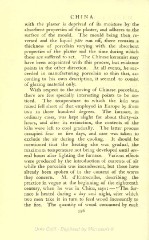Page 482 - Oriental Series Japan and China, Brinkly
P. 482
CHINA
with the plaster is deprived of its moisture by the
absorbent properties of the plaster, and adheres to the
surface of the mould. The mould being then re-
versed and the liquid pate run off, there remains a
thickness of porcelain varying with the absorbent
properties of the plaster and the time during which
these are suffered to act. The Chinese keramist may
have been acquainted with this process, but evidence
points in the other direction. At all events, he suc-
ceeded in manufacturing porcelain so thin that, ac-
cording to his own description, it seemed to consist
of glazing material only.
With respect to the stoving of Chinese porcelain,
there are few specially interesting points to be no-
ticed. The temperature to which the kiln was
raised fell short of that employed in Europe by from
two to three hundred degrees. The furnace, in
ordinary cases, was kept alight for about thirty-six
hours, and after its extinction, the contents of the
kiln were left to cool gradually. The latter process
occupied four or five days, and care was taken to
exclude the air during the cooling. It should be
mentioned that the Keating also was gradual, the
maximum temperature not being developed until sev-
eral hours after lighting the furnace. Various effects
were produced by the introduction of currents of air
while the porcelain was incandescent, but these have
already been spoken of in the context of the wares
they concern. M. d'Entrecolles, describing the
practice in vogue at the beginning of the eighteenth
century, when he was in China, says : " The fur-
nace is heated during a day and night, after which
two men take it in turn to feed wood incessantly to
the fire. The quantity of wood consumed by each
396

